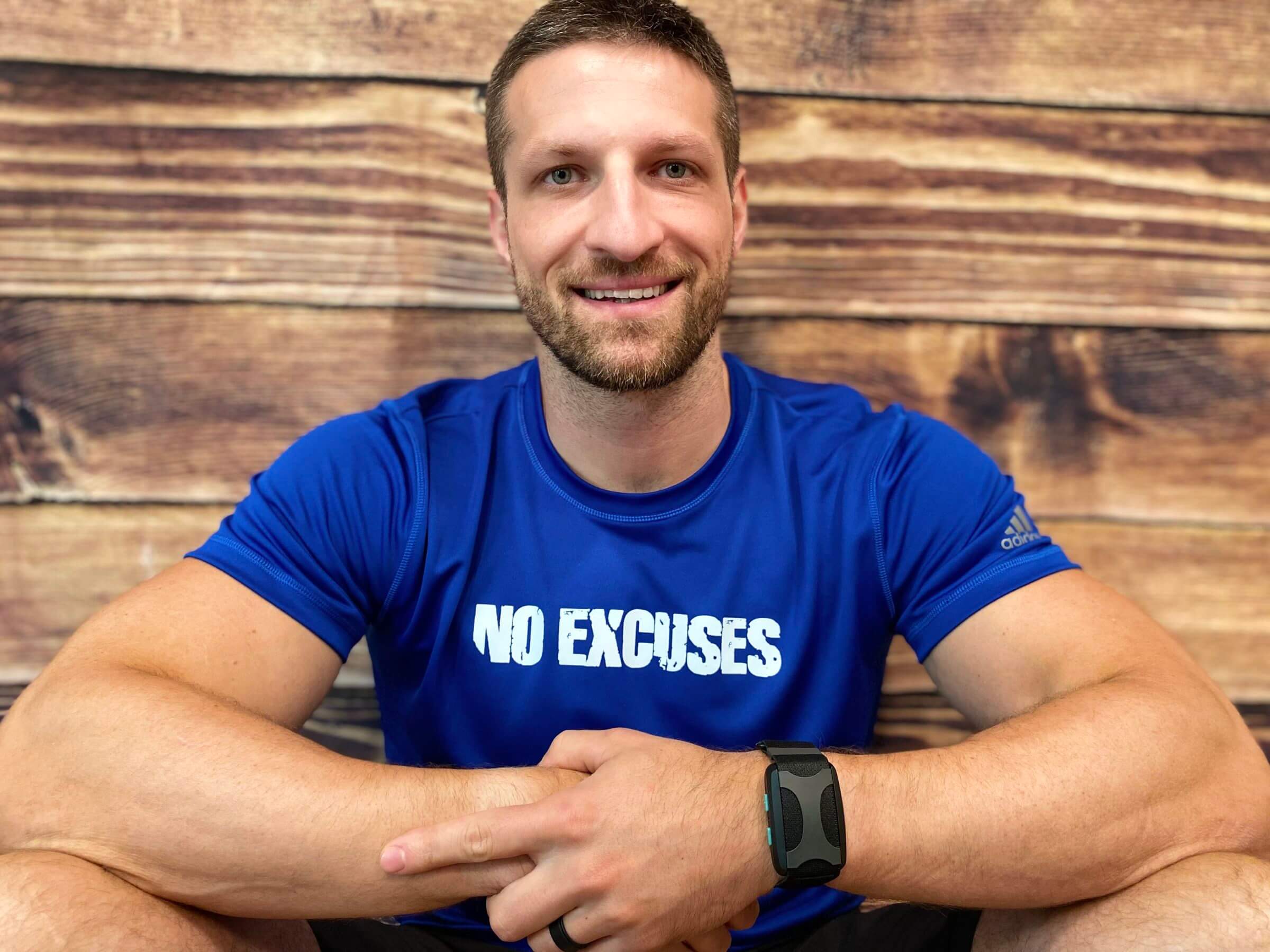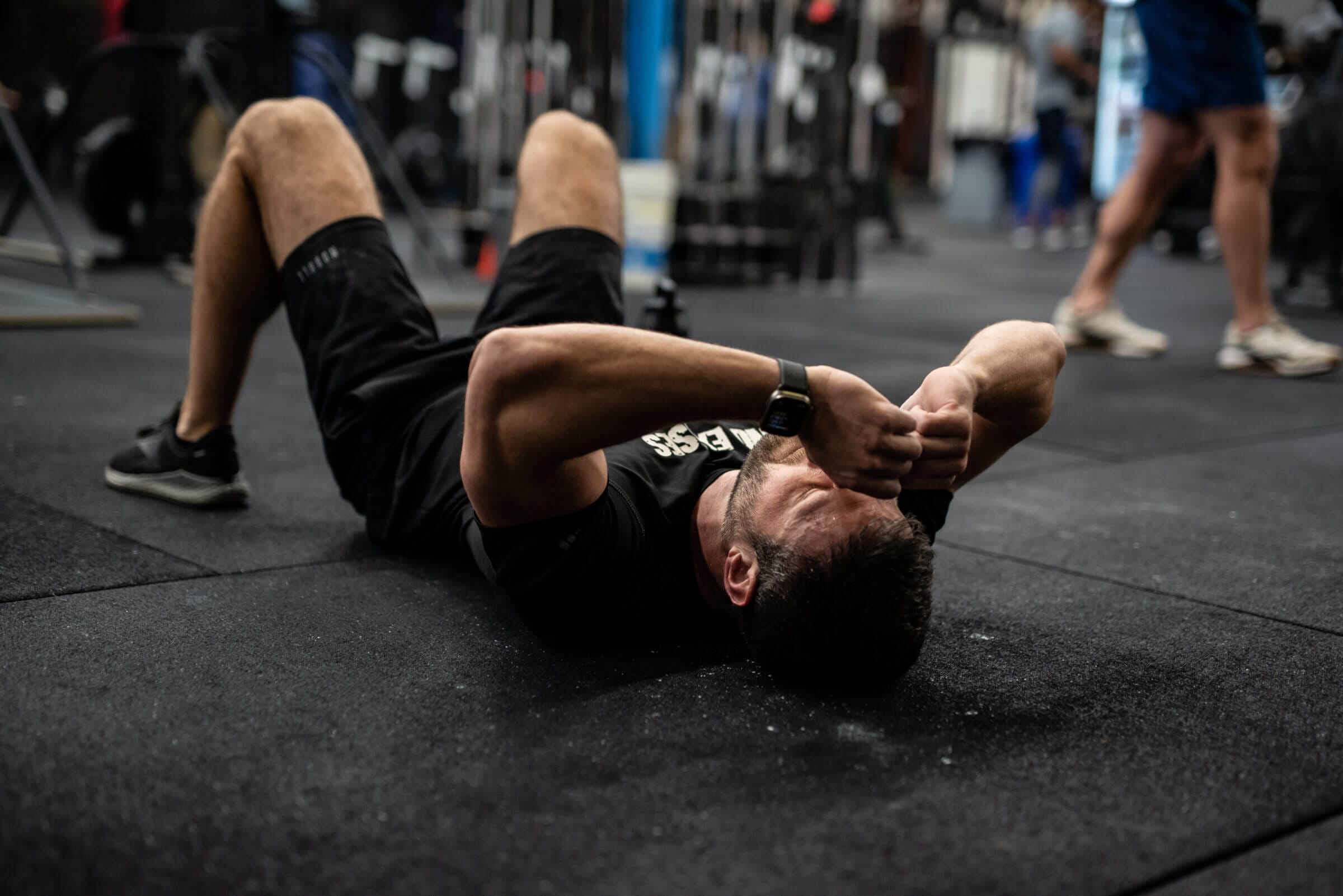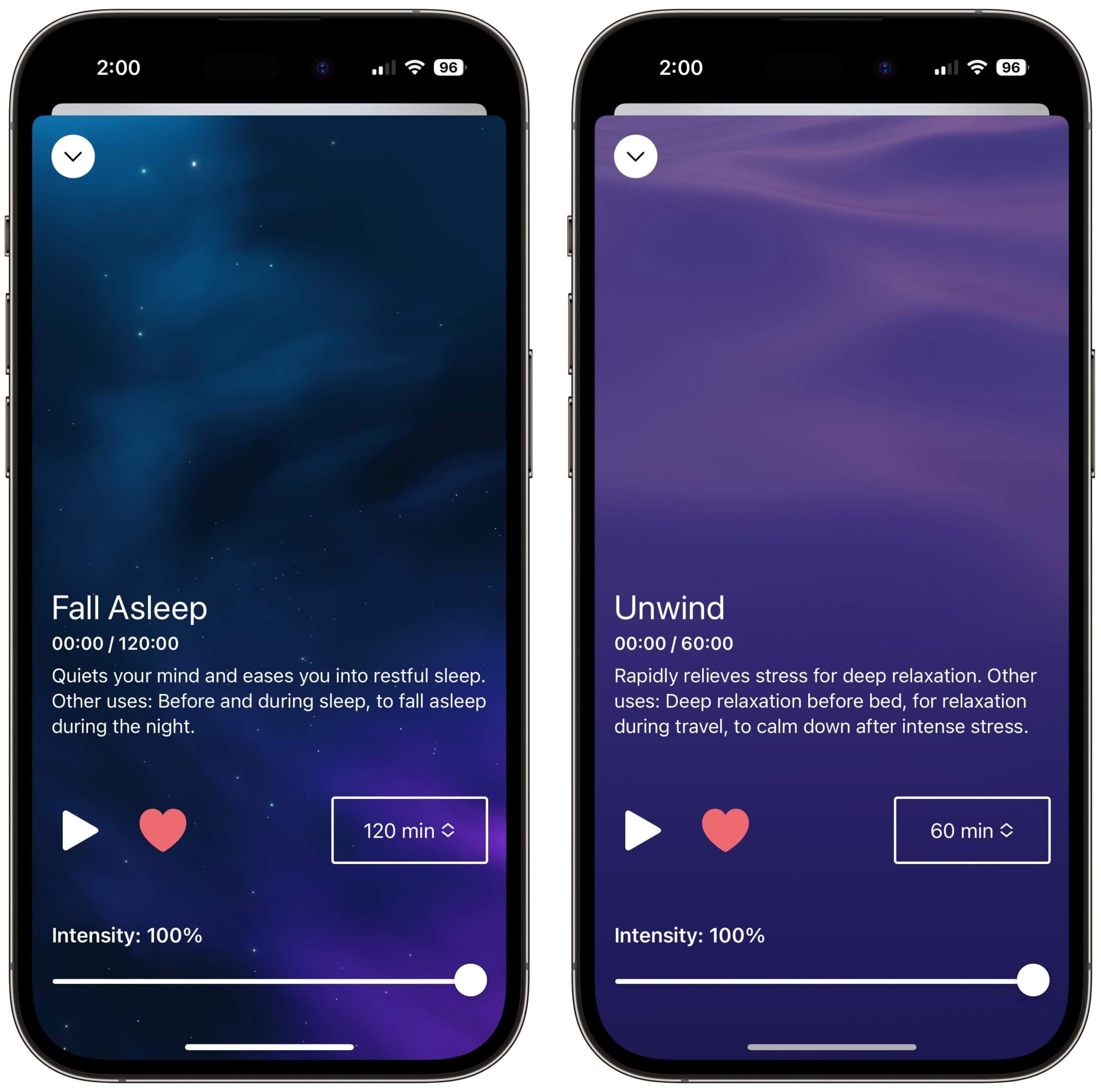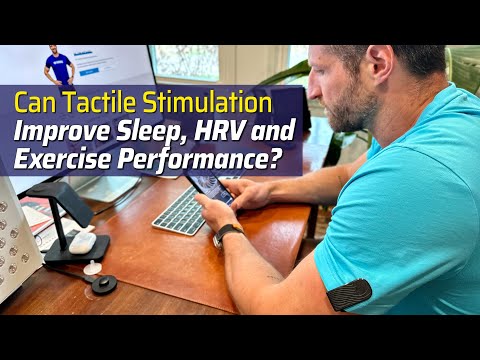Apollo is a wearable device that was developed by neuroscientist Dr. David Rabin. It uses gentle vibrations to influence your nervous system to help you reduce stress, enhance your physical performance and recovery, improve your sleep quality, and increase your heart rate variability (HRV).
I’ve been leveraging Apollo’s touch therapy technology since the summer of 2020 and documented my experience with the device in an in-depth Apollo Neuro review. For this article, I wanted to take a deep dive into the science behind four of Apollo’s top purported health benefits, including:
- Better nervous system regulation
- Increased HRV
- Enhanced performance and recovery
- Improved sleep quality
Before we dive into the details, let me briefly explain how Apollo works.
What Apollo Neuro Does
In a nutshell, Apollo influences the balance between the sympathetic and parasympathetic branches of your autonomic nervous system. These two branches are in constant competition with each other, like two people pulling on opposite sides of a rope.
For example, when you’re calm and relaxed, the parasympathetic branch of your nervous system is in control, indicated by an elevated heart rate variability, dilated pupils and a low heart rate and blood pressure.
However, when you’re under stress (due to physical or mental factors), your body goes into a fight-or-flight mode, which leads to the sympathetic branch of the nervous system taking over. In such a state, you’ll experience a lowered HRV, elevated heart rate and blood pressure and narrowed pupils.
The way our bodies react to stressors is based on ancient mechanisms that were meant to keep us alive in life-threatening situations. Unfortunately, the ancient parts of our brains can’t distinguish between old and new stressors.
In other words, a nine-minute reduced-exertion high-intensity interval training workout on my CAROL bike elicits the same stress response as an attack from a sabertooth tiger. In both cases, the body goes into full fight-or-flight mode, causing the sympathetic branch of the nervous system to shift into overdrive.
That’s where Apollo comes in. The gentle vibrations emitted by Apollo re-activate the parasympathetic branch of the nervous system, which automatically down-regulates the sympathetic branch, thus allowing you to calm down and go back into rest, digest and repair mode.
Please keep that underlying mechanism in mind when you read through the following sections.
Better Nervous System Regulation

Improved nervous system regulation is arguably the main benefit of Apollo. In other words, all the other Apollo benefits mentioned in this article are reflections of a properly balanced nervous system.
As of this writing, Apollo’s efficacy in helping regulate the nervous system is backed by seven completed and 14 ongoing clinical trials.
For example, a double-blind randomized placebo-controlled crossover trial conducted by the University of Pittsburgh with some of its varsity athletes reported that Apollo triggered a statistically significant increase in HRV among all study participants. In another double-blind randomized placebo-controlled crossover clinical trial involving 38 healthy adults, Apollo vibrations improved heart rate variability (HRV) and cognitive performance under stress.
Based on my experience with Apollo over the past few years, I can say this wearable has improved the workings of my autonomic nervous system in two ways.
On one hand, Apollo helped during times when I was in acute sympathetic overdrive.
For example, our freezer — which contained thousands of dollars worth of grass-fed beef — broke down after only three months of use. When I called the manufacturer’s hotline, I was confronted with an unskilled customer support agent that was reading off a script instead of trying to understand my problem and the urgency to get the appliance fixed.
Unfortunately, I wasn’t able to keep my cool after the company canceled our first repair appointment and didn’t show up for the second one. At that point, I was in sympathetic overdrive and in full fight mode.
Apollo helped me to calm down in this and countless other situations when I was exposed to stressors I couldn’t mitigate through sheer willpower. A few minutes of using Apollo led to an immediate drop in heart rate and blood pressure, while getting my HRV back to baseline.
I also strategically use Apollo when I feel overwhelmed by my never-ending to-do list. As soon as I feel the slightest signs of “to-do list anxiety,” I slap on Apollo and let the Calm vibe (one of its eight vibration patterns or programs) run for an hour.
Of course, it’s always better to anticipate rough times. So if I know that I’ll have a few stressful hours or days ahead of me, I’ll use Apollo proactively (which has helped me remain in a more balanced state).
On the other hand, by consistently using Apollo (in combination with other lifestyle factors), I’ve managed to lower my resting heart rate from the mid-50s to the mid-40s, and I have increased my HRV by 50%.
Increased HRV

Aside from measuring vagal tone by tapping the vagus nerve (an invasive procedure I don’t recommend), the best way to measure nervous system activity is by monitoring heart rate variability (HRV). In other words, your HRV is an indirect indication of the competition between the sympathetic and parasympathetic branches of your nervous system.
A low HRV (relative to your baseline) indicates that your sympathetic nervous system is in overdrive, whereas a relatively high HRV indicates parasympathetic dominance. In a sense, an elevated HRV is a product of a well-regulated nervous system (see above).
Based on all the completed and ongoing clinical trials involving Apollo, users have experienced an 11% increase in HRV on average. That’s not only statistically relevant, but also a meaningful improvement that can trigger several downstream benefits, including faster physical recovery, less stress and feelings of anxiety, more focus and concentration, and better sleep.
I’ve been measuring my HRV using a combination of wearables and apps, including WHOOP, Oura Ring, Eight Sleep and EliteHRV, and have noticed higher HRV readings while sleeping when wearing Apollo consistently.
Of course, the tactile vibrations of Apollo are just one tool you can use to improve your HRV. Check out my article on how I’ve improved my HRV by 50% to learn more.
Enhanced Performance and Recovery

Intense exercise is an acute stressor that helps the body adapt and become stronger and more resilient. However, if you’re a professional athlete, you have to walk a fine line between pushing your body to its limits and pushing it beyond its limits. The latter can lead to an increased injury risk and reduced performance in the long run.
That’s why many athletes and serious fitness enthusiasts invest significant resources into recovery modalities such as percussion massage therapy devices, transcutaneous electrical nerve stimulation (TENS), red light therapy, infrared sauna bathing and cold plunging.
The use of vibration patterns (i.e., via devices like Apollo) has only recently become a popular recovery tool.
The basic principle is to intentionally upregulate the parasympathetic nervous system at a time when it’s naturally suppressed by intense exercise. In other words, it helps your body to get out of the fight-or-flight state faster so that it can immediately start its recovery process.
To find out how effective Apollo is at accomplishing that goal, scientists equipped 40 elite college athletes with Apollo and told them to use the device before and after workouts. The scientists measured each athlete’s biometrics — such as heart rate, HRV, blood pressure and blood glucose — with and without Apollo.
The preliminary findings look promising:
- With the help of Apollo, all 40 athletes improved their HRV and recovery after intense workouts.
- Using Apollo led to a 10-15 point decrease in heart rate and systolic blood pressure within five minutes of concluding an intense workout (as compared to baseline).
- All athletes also experienced lowered blood sugar levels following a carbohydrate challenge, an indication of improved insulin sensitivity (which is crucial not only for optimal health but also for improving recovery after intense workouts, because the quicker your body can absorb glucose and shuttle it into cells where it’s needed for energy production, the more efficiently the body’s repair processes function).
- As far as performance is concerned, athletes using Apollo also managed to enhance the consistency of their peak performance. In other words, they could complete more reps in the same amount of time when using Apollo (compared to their baseline).
The study noted above is still ongoing and we don’t yet know the final results. But the preliminary findings match those of a previously-published peer-reviewed study conducted by the University of Pittsburgh, which found that using Apollo improves athletic recovery and HRV.
While I’m no longer a professional athlete, I still do CrossFit several times a week and enjoy pushing my aging body to its limits. I’ve noticed that when I use Apollo consistently, I tend to recover quickly from intense workouts, especially when I wear Apollo before and after a workout.
I’ve also noticed that my sleep improves when I wear Apollo before bed. Good sleep is essential for allowing the body to recover and repair after physical activity, and it’s likely another contributing factor for how Apollo has helped me improve my recovery and performance.
Improved Sleep Quality

The preliminary results of one Apollo-supported study involving 582 participants using an Oura Ring for sleep tracking concluded that wearing Apollo consistently (three hours a day, five days a week over a three-month period) led to the following improvements:
- 19% average increase in deep sleep.
- 14% average increase in REM sleep.
- 6% average increase in total sleep time.
- 4% average decrease in resting heart rate.
- 11% average increase in HRV.
Apollo has also launched a clinical trial involving 6,000+ Oura Ring users to study how the device can help improve sleep. You can sign up for that trial here if you’d like to participate.
As I mentioned earlier in this article, I’m not a pro athlete and optimal exercise performance and recovery aren’t mission-critical for me. However, I consider good sleep the foundation of optimal health, and I do everything I can to sleep well.
Considering that I maintain a consistent sleep routine, avoid artificial blue light (or wear blue light glasses), and avoid stimulants (such as caffeine) in the evening, and expose myself to natural sunlight in the morning and during the day, I sleep well most nights.
However, my life isn’t perfect and sometimes my head doesn’t stop spinning because I’m thinking about a negative comment from a reader or viewer, or planning what I want to say in my next YouTube video. In cases like those, I grab Apollo, enable airplane mode, and let the gentle vibrations help balance my stress response.
Coincidentally, I had an overactive mind last night (I was thinking about an upcoming YouTube video). So I got up, grabbed Apollo and enabled the “Fall Asleep” program. Immediately, I noticed my respiratory rate and heart rate to slow down, and I was sound asleep within a few minutes.
This morning I woke up at 5:52 a.m. after 7 hours and 36 minutes of sleep, including 146 minutes of REM and 39 minutes of deep sleep (according to my Apple Watch Ultra). Assuming those numbers are correct, it appears as if my brain spent a lot of time consolidating memories (indicated by 2 hours and 26 minutes of REM sleep). That night, I was awake for only 6 minutes. That’s incredible, considering I usually spend 30-40 minutes awake throughout the night.
While I do think we need much more research to understand better how tactile stimulation impacts the quality of our sleep, I’ve experienced and measured how Apollo has improved my sleep by enabling me to spend more time in the restorative phases of sleep and to spend less time awake.
Besides using Apollo, I also recommend experimenting with a high-quality magnesium supplement before bedtime to optimize sleep further. Both my wife and I have been taking magnesium before going to bed to reduce stress because magnesium levels are closely correlated with stress levels.
Other Benefits of Apollo

Remaining in a state of chronic stress can be a contributing factor to a host of health issues, and can make traditional treatment options less effective. For example, patients with PTSD, anxiety disorders or ADHD are often in constant sympathetic overdrive.
Studies involving Apollo have shown that tactile stimulation can help improve mood and behavior and reduce the symptoms associated with such disorders.
Additionally, Apollo has been shown in studies to provide the following benefits:
- Improved cognitive performance. A study involving 38 healthy adults showed that Apollo can increase focus and concentration by up to 25%. The same study also found that Apollo reduced self-reported stress, pupil dilation, galvanic skin response and respirations (all symptoms of sympathetic activity and stress). That’s one of the reasons why I frequently use Apollo while working on new blog posts like this one.
- Easier access to meditation. A study conducted by the University of Pittsburgh with 50 meditators shows that Apollo can help achieve deeper meditative states in both experience and naive meditators.
- Reduced stress: A study conducted in a skilled nursing facility found that wearing Apollo reduced the stress of nursing staff by 40%.
To learn more about those findings, check out Apollo’s studies roundup page.
Where to Buy Apollo
The Apollo wearable is available in different colors and you can purchase it directly from apolloneuro.com. Unfortunately, Apollo isn’t available on Amazon or other online retailers as of this writing.
The device retails for $349, but if you use the link above, you get a 15% discount!
Frequently Asked Questions
As of this writing, Apollo offers several different modes (the company calls them vibes) as part of the Apollo Neuro app: Energy (formerly known as Energy and Wakeup), Social (formerly known as Social and Open), Focus, Power Nap, Recover (formerly known as Rebuild and Recover), Calm, Unwind (formerly known as Relax and Unwind) and Fall Asleep (formerly known as Sleep and Renew).
To learn more about how I use those programs, check out my in-depth Apollo Neuro review.
There are a lot of stress relief gadgets on the market that “work” thanks to a placebo effect. I don’t necessarily consider that a bad thing. If you believe in a gadget and it measurably helps you lower your stress levels or slow down your heartbeat, then it has value. However, the growing number of clinical trials showing Apollo’s effectiveness suggest that the type of touch therapy leveraged by the device has a meaningful impact beyond any placebo effect.
I firmly believe that both Apollo and mindfulness are effective at controlling your fight-or-flight response, reducing stress levels and improving HRV and related biomarkers. The advantage of meditation is that it doesn’t cost you anything but time. The advantage of Apollo is that you can use it while doing other things, such as working or having dinner with your family.
So I encourage you to experiment with both modalities and reap the benefits of both worlds.
Summary and Final Thoughts

Based on everything I’ve learned about heart rate variability and the impact of stress (good or bad) on my health and well-being, I’ve become a firm believer in using low-frequency touch therapy to help balance my nervous system.
Apollo has been an effective tool in my wellness toolkit to improve my recovery after intense workouts, lower my stress levels and improve my sleep. Even my wife grabs Apollo when she feels anxious or overwhelmed by a situation, because she has realized how quickly Apollo gets her nervous system back to a more balanced state.
Have you experimented with tactile stimulation, or do you own Apollo? If so, what has been your experience? Let me know by leaving a comment below!

Michael Kummer is a healthy living enthusiast and CrossFit athlete whose goal is to help people achieve optimal health by bridging the gap between ancestral living and the demands of modern society.
Medical Disclaimer
The information shared on this blog is for educational purposes only, is not a substitute for the advice of medical doctors or registered dieticians (which we are not) and should not be used to prevent, diagnose, or treat any condition. Consult with a physician before starting a fitness regimen, adding supplements to your diet, or making other changes that may affect your medications, treatment plan or overall health. MichaelKummer.com and its owner MK Media Group, LLC are not liable for how you use and implement the information shared here, which is based on the opinions of the authors formed after engaging in personal use and research. We recommend products, services, or programs and are sometimes compensated for doing so as affiliates. Please read our Terms and Conditions for further information, including our privacy policy.